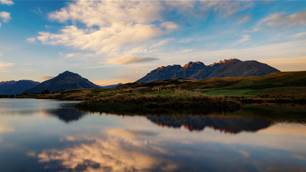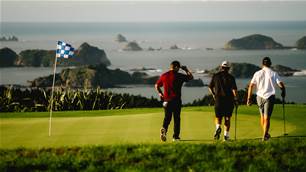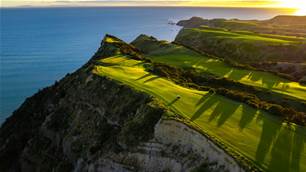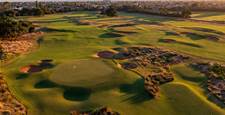New Zealand’s largest city, Auckland, is many things.
Cape Kidnappers has been one of the golf world’s most talked about courses since it opened nearly two decades ago.
Of course, any designer could have put their name to a decent course in this spectacular location. But owner, the late Julian Robertson (who also developed Kauri Cliffs), pulled off a masterstroke in commissioning Doak to create Cape Kidnappers, which is far more than a decent course … it is spectacular.
Doak’s minimalist design draws plenty out of the location and provides each golfer who tees it up with a thrill ride they will never forget. Faced with having to route the course along, and across, fingers of land surrounded by jagged cliffs that stretch 150 metres (500 feet) above the ocean, Doak has created holes that are not only playable (nearly all the long holes play with the prevailing wind) but are a lot of fun to play.
It is the dramatic holes away from the cliffs, often overlooked for their quality, that you will be pleasantly surprised by. This stunning terrain, the deep dramatic bunkering and some of Doak’s best green complexes all produce a brilliant collection of inland holes more akin to the heathland style of course architecture, rather than links.
At the request of the owners, Doak returned to Cape Kidnappers in 2022 to oversee a major renovation of his creation, which included the re-grassing of all 18 fairways and greens.
“We were determined to restore the firm and fast turf conditions that Doak first created — because bounce and roll are vital to the strategic function of links designs, heathland designs and one-of-a-kind hybrids like Cape Kidnappers,” Director of Golf, Ray Geffre, said.

“Working with Doak and ace shaper Angela Moser, course superintendent Brad Sim oversaw the work. We rebuilt the putting surfaces from 10 inches down and Angela put the contours back exactly as they’d been before.
“Re-grassing the greens at Cape and addressing our thatch problem was pretty straightforward. But the fairways were a huge undertaking — just an enormous volume of turf for an in-house crew to peel back and replant.”
Doak, whilst being a great designer, also has a trained eye for great courses. He, like his collaborative designer on Barnbougle Dunes, Mike Clayton, hold the layout at Paraparaumu Beach Golf Club in the highest esteem.
Doak has even listed Paraparaumu (pronounced Para-param) in his top-14 links courses in the world, alongside the likes of the Old Course at St Andrews, Royal County Down, Royal Dornoch and Ballybunion.
Designed by Alister MacKenzie’s Australian protégé, Alex Russell, in 1949, Paraparaumu covers rugged, windswept Kapiti Coast dunesland, about 45 minutes’ drive north of the nation’s capital, Wellington, or about four hours’ drive south of Cape Kidnappers.
Despite the encroachment on its borders of the surrounding beachside suburb, the bones of the course have changed very little since Russell signed off on his creation. But it became apparent during the 2002 New Zealand Open – when Tiger Woods made his first appearance in the country – some of the layout’s links character had been lost.
But superior presentation and changes to the course set-up in the years since have recaptured its links roots and character and today is widely regarded as the best links course in New Zealand.
General Manager and Course Superintendent Leo Barber is a keen student of the game and under his management the course set-up is more reflective of Russell’s guidance, greens surrounds have been closely shaved to place a premium on greater accuracy on approach shots. These tight cropped areas drop steeply off the edge of elevated greens that now play firm and fast, just like the fairways. Several deep bunkers around the course have been revetted, making them formidable hazards.
While the course can never be lengthened, it doesn’t need extra length to be a tough challenge especially when the wind blows with any kind of strength.

Some of the best holes are on the inward nine with the 404-metre par-4 17th being a standout. The hole features a split fairway where you can shorten the hole by using the right fairway, but this leaves a harder second shot to a green that sits diagonally to the approach. Driving left leaves a long more straight-forward shot to a green that slopes away left, right and back.
Fans of traditional rugged links courses will simply love Paraparaumu, but if your taste is more satisfied by well-manicured beauty, then Royal Wellington Golf Club should be on your itinerary.
Royal Wellington is one of New Zealand’s most beautiful and historic golf courses.
Having been founded in 1895, the club moved to its current site at Heretaunga on the banks of the beautiful Hutt River – about 30 minutes’ drive north of Wellington’s CBD – in 1908.
The esteemed club hosted its first of many New Zealand Open championships just four years later.
In the years that followed, some history making championships were contested at Wellington, which was granted the ‘Royal’ charter in 2004.
The layout remained basically unaltered for 64 years until l972 when the club, having purchased adjoining land, laid out a new l8-hole course designed by Sloan Morpeth, which opened for play in early 1974.
But the evolution and growth of the par-72 saw the course become a victim of its heavily-treed landscape and by the early 2000s, dense stands of oak, maple, elm and macrocarpa lining the fairways had encroached into the playing lines.
In 2010 course architecture team Greg Turner and Scott Macpherson presented a design plan to the club that ultimately led to a new course being built, which opened for play in 2014. Only five holes are routed across the same terrain, in the same direction, as they were before the rebuild. All 18 greens were rebuilt.

Turner and Macpherson’s creation has certainly improved the quality of a round here. While the landscape generally remains relatively flat and easy-to-walk, the design duo massaged subtle undulations into the fairways adding a level of strategy to the golf that had previously been missing at Royal Wellington. Streams and marshland across the course have also been better incorporated into the parkland layout.
A great example of this can be found on the 499-metre par-5 4th hole where questions are asked of your game on each shot from tee-to-green. From the tee, you are confronted by a fairway that is split in two by a creek. You can try and carry the water and avoid a well-placed bunker on the left or take the shorter option to the right side of the fairway, which is a decision easily influenced by the wind direction. Over the stream, the fairway cambers towards a lake and narrows dramatically as it gets closer to the green. The wide but shallow green lies nearly at right angles to the line of play, makes hitting the green with a long approach a tough ask.
Royal Wellington has well and truly moved on from being just a ‘pretty face’. The now decade old rebuild has provided much substance and enjoyment to a round across the flats next to the Hutt River.
WHERE TO PLAY
1. ROYAL AUCKLAND & GRANGE GC
Green fee: On application from member’s guest and international visitors.
2. WINDROSS FARM
Green fee: NZ$165.
3. TITIRANGI GC
Green fee: NZ$200.
4. MURIWAI GC
Green fee: NZ$140.
5. GULF HARBOUR CC
Green fee: NZ$140 (Mon-Thu); NZ$200 (Fri-Sun).
www.gulfharbourcountryclub.co.nz
6. TE ARAI LINKS
Green fee: NZ$650 (high season).
7. TARA ITI
Green fee: Private club. Upon application for a tee time.
8. MANGAWHAI GC
Green fee: NZ$110.
9. KAURI CLIFFS
Green fee: NZ$692 (high season).
10. CARRINGTON ESTATE
Green fee: NZ$180.
11. WAIRAKEI GOLF + SANCTUARY
Green fee: NZ$270.
12. THE KINLOCH CLUB
Green fee: NZ$500 (high season).
13. CAPE KIDNAPPERS
Green fee: NZ$692 (high season).
14. PARAPARAUMU BEACH GC
Green fee: NZ$190.
www.paraparaumubeachgolfclub.co.nz
15. ROYAL WELLINGTON GC
Green fee: NZ$275.
Related Articles

Take your golf game to the edge of the world in New Zealand

Touring New Zealand: The complete golfing package













